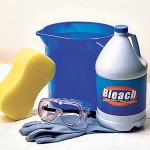Handy Solutions for Common Interior Paint Problems
Now is the perfect time to look around your home and take stock of areas in need of repair or an inexpensive spruce up with the holiday season on the horizon.
“A simple change of paint color can rejuvenate a tired kitchen, warm a family or living room or help to create a restful bedroom. But, before opening that first can of paint, correct surface issues and make sure your walls are clean and sound. Good surface preparation coupled with top-quality paint, brushes and rollers will help to insure a long-lasting and beautiful finish,” Debbie Zimmer, color and decorating expert with the Rohm and Haas Paint Quality Institute explained.
Here are some common interior surface paint problems:
1. Foaming or cratering. This occurs during the formation of bubbles and results in small, round concave depressions when those bubbles break during paint application and drying.
Possible causes include shaking a partially filled can of paint, using low-quality paint or very old latex paint, applying paint too quickly or excessive rolling and brushing, using a low-quality roller cover or wrong nap length, or applying a gloss or semigloss paint over a porous surface.
All paints will foam to some extent during application, however, higher-quality paints are formulated so bubbles break while the paint is still wet, allowing for good flow and appearance. Apply gloss and semigloss paints with a short-nap roller and apply a sealer or primer to porous surfaces before painting.
2. Mildew. The black, gray or brown areas of fungus growth can occur on paint or caulk surfaces. Mildew forms most often on areas that tend to be damp with little or no sunlight. Ideal areas include bathrooms, kitchens and laundry rooms.
Possible causes include using low-quality paint with minimal or no additives to prevent growth, painting over a surface where the mildew has not been removed or applying paint in “too thin” of a coat.
First, test for mildew by applying a few drops of household bleach to the discolored area, then rinse; if it disappears, it is probably mildew.
Remove all mildew from the surface by scrubbing with a diluted bleach solution (one part bleach, three parts water). Be sure to wear proper safety protection, including rubber gloves and eye protection. Rinse thoroughly, prime bare surfaces and paint. To protect against mildew, use a top-quality latex paint and clean when necessary with bleach/detergent solution. Consider installing an exhaust fan in high-moisture areas.
3. Brush and roller marks from poor paint flow and leveling. Failure of the paint to dry to a smooth film results in unsightly marks or patterns after the paint dries.
Possible causes include using low-quality paint, the wrong type of roller cover or a low-quality brush. This also occurs from adding additional paint to “touch up” partially dried painted areas and re-brushing or re-rolling partially dried painted areas.
Use high-quality paints to prevent this problem from occurring. Quality paints contain ingredients that enhance paint flow and form a smooth film. When using a roller, be sure to use a cover with the recommended nap length for the type of paint being used. Use a high-quality brush because a poor brush can result in poor flow and leveling.
For more information about all of your painting needs, visit the website www.paintquality.com.
The Paint Quality Institute (SM) was formed by Rohm and Haas Company in 1989 to educate people on the advantages of using quality interior and exterior paints and coatings. This article is courtesy of the Home Improvement News and Information Center.
Transform your space with unexpected color
For today’s homeowners who are seeking easy ways to update their homes on a do-it-yourself budget, nothing transforms the look and feel of a room as quickly and affordably as a fresh coat of colorful paint.
“Every home has the potential to look amazing — inside and out,” said HGTV star and interior designer David Bromstad. He offers these tips for sprucing up a space with color:
Highlight unexpected areas
Paint can go beyond walls. You can put it on unexpected surfaces, such as ceilings and accessories. Try a bright hue on the interior of a bookshelf or stair risers for a fun twist.
Use white on trim to make your color pop
White trim is classic and elegant, so you never get sick of it, and it’s a fantastic way to highlight color on your walls.
Paint furniture
If you prefer to keep your walls neutral, a great way to add color is by painting a side table, chair or armoire. This spices up the space and makes it easy to change your room’s look.
Coordinate your color transitions
For high-impact transitions, combine bolder shades with neutral counterparts. For a more tranquil transition, stick to softer or lighter shades that are from the same color family.


